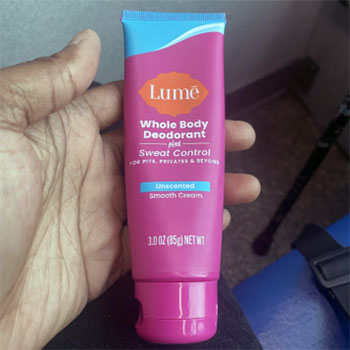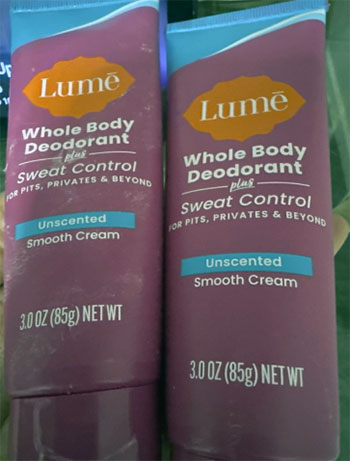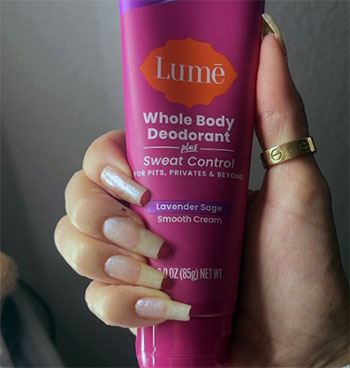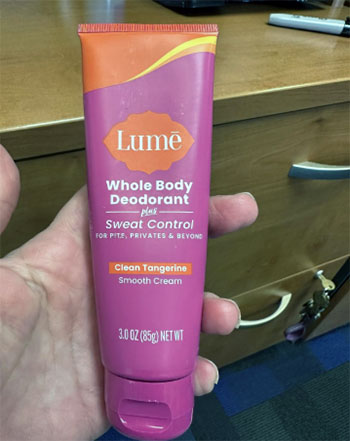If you have ever cancelled a lunch date because you were worried about the humidity index or stealthily checked your underarms in a public restroom mirror, you know the quiet anxiety of sweat management. We live in a world that expects us to be effortlessly dry and odorless, yet our bodies often have other plans.
Lume Sweat Control—specifically their Whole Body Deodorant Plus Sweat Control line—claims to be the answer to those prayers, promising to tackle moisture and smell in places most deodorants fear to tread. If you are tired of juggling three different products for three different body parts and want a singular, heavy-hitting solution, this review will tell you if Lume is the miracle tube you’ve been waiting for. You can find their full range of products directly on the Lume website or via major retailers like Amazon and Target.
My Experience With Lume Sweat Control
I didn’t come to Lume because I wanted to; I came to it because I was desperate. Living in a climate where “air you can wear” is a daily weather description, I had accepted that a certain level of dampness was just my reality. But last summer broke me. It wasn’t just the underarm sweat—I had clinical strength sticks for that. It was the “everywhere else” sweat. Under-boob humidity, the dreaded thigh chafe caused by moisture, and the general feeling of being a walking swamp by 2 PM.

I had seen the quirky, slightly TMI ads on social media featuring Dr. Shannon Klingman.
While I appreciated the candor, I was skeptical. Could one cream really go everywhere and actually stop sweat? I decided to test the “Whole Body Deodorant PLUS Sweat Control” cream tube.
Note the distinction: I didn’t buy the standard deodorant (which is aluminum-free and only handles odor); I bought the Sweat Control version which contains aluminum salts to actually block moisture.
The first thing you notice when you squeeze the tube is the texture. It looks and feels exactly like a lightweight hand lotion.
It’s not a waxy stick or a gritty paste. I applied a pea-sized amount to my underarms and, feeling brave, a small amount under my chest band and along my bikini line.
Here is the truth about the “Lume smell” that everyone whispers about: straight out of the tube, it smells… weird. It has a tangy, almost sour yogurt scent. This is the Mandelic Acid, the secret sauce that lowers skin pH to kill bacteria. The good news is that the smell vanishes in about 30 seconds as it dries down.
My first day wearing it was a trial by fire—a humid outdoor flea market. Usually, within an hour, I’d feel the trickle of sweat down my ribcage. With Lume, I waited for it, but it didn’t come. My underarms stayed bone dry, which was expected, but the real shock was my torso. The skin under my bra band remained matte and dry. I didn’t experience that sticky, friction-heavy feeling that usually ruins my mood.
However, it wasn’t a flawless victory. I learned the hard way that you cannot apply this immediately after shaving sensitive areas—it stings. I also found that if I used too much, it left a chalky white residue on my dark sports bra. But as the week went on, I realized I wasn’t doing my midday “sniff check” or worrying about raising my arms. The odor protection is legitimate; even after a workout, I didn’t smell like sweat or masking fragrance. I just smelled like nothing. For a product to control moisture in the groin area without causing irritation (after the initial shave sting lesson) is rare. It felt less like a beauty product and more like a hygiene shield I didn’t know I needed.
Read More: My Thoughts On Malin + Goetz Deodorant
Pros Of Lume Sweat Control
- True “Whole Body” Versatility: Most antiperspirants are designed strictly for the thick skin of the underarms. If you try to put a standard Secret or Old Spice stick on your inner thighs or under your breasts, you are asking for clogged pores and irritation. Lume’s formula is gynecologist-developed and water-based, meaning it is gentle enough for your most sensitive external crevices while still being powerful enough for your pits. It bridges the gap between a beauty cream and a medical antiperspirant.
- Dual Action (Sweat AND Odor): The standard Lume product is famous for blocking odor via acidification, but it does nothing for wetness. The “Sweat Control” line combines that acidification technology with aluminum sesquichlorohydrate. This means you aren’t just masking the smell of sweat; you are physically stopping the sweat from exiting the pore and creating an environment where odor-causing bacteria cannot survive. It is a double-barreled approach that few other brands offer in a single tube.
- Precision Application: The cream tube format is a massive advantage over stick deodorants. With a stick, you are painting broad strokes, often missing creases or over-applying to surrounding skin. With the lotion-like cream, you can dispense a tiny bead on your fingertip and apply it exactly where you need it—right in the fold of the leg or directly in the center of the chest—without getting residue everywhere else.
- 72-Hour Efficacy Claims Hold Up: While “72 hours” sounds like marketing fluff, the endurance of this product is impressive. I found that I could skip a morning shower if I was running late and still be perfectly dry and odorless from the application the day before. It seems to bind to the skin effectively, surviving light activity and sleep without needing a refresh.
- Prevents Chafing Indirectly: While not marketed as an anti-chafe balm, the sweat control aspect significantly reduces friction. Chafing is usually caused by skin rubbing against skin in the presence of moisture. By removing the moisture equation, my thighs glided rather than stuck, which saved me from the dreaded “chub rub” rash during long walks.
- Safe for Private Areas: This is the brand’s main selling point for a reason. Finding a product that controls groin sweat without disrupting your natural pH balance or causing a yeast infection is difficult. Lume is formulated without baking soda (a common irritant) and is pH-optimized, making it arguably the safest option for intimate area sweat management on the market.
Cons Of Lume Sweat Control

- The “Base” Scent: There is no getting around it—the unmasked scent of the active ingredients is polarizing. Because Lume uses Mandelic Acid derived from almonds to lower pH, the cream has a distinct, sour, yeasty smell when it is wet. While the brand swears this dissipates (and it does), that first 30 seconds can be off-putting. If you have a sensitive nose, you might think the product has gone bad, but that is just the smell of the chemistry at work.
- High Price Point: Compared to a $6 drugstore stick, Lume is an investment. A small 2.2-ounce tube costs significantly more than traditional deodorants. If you are using it for “whole body” application—pits, thighs, feet, underboob—you will burn through a tube relatively quickly. It forces you to ration the product, treating it like liquid gold rather than a daily staple.
- Residue on Dark Clothing: The cream is white. If you are not careful to rub it in completely until it vanishes, it will transfer onto clothes. I noticed white streaks on the inside of my black leggings and sports bras. Unlike clear gels, this requires you to wait a few minutes for it to dry before getting dressed if you want to protect your fabrics.
- Tube Packaging Issues: While the tube allows for precise application, the plastic can sometimes split at the crimped end if you squeeze it too aggressively, or the cap can get gunked up with dried cream. Since the product is water-based, if the cap isn’t snapped shut tight, the cream near the opening can dry out and form a hard plug that wastes product.
- Adjustment Period for Skin: If you are switching from a standard silicone-heavy antiperspirant, your skin might react to the Mandelic Acid initially. Some users report a slight tingling sensation or peeling (exfoliation) because it is an alpha hydroxy acid. It is not just sitting on top of your skin; it is interacting with it, which can be intense for those with hypersensitive skin barriers.
- Confusion Between Product Lines: Lume sells “Deodorant” (Orange label usually) and “Antiperspirant” (Sweat Control). They look almost identical. It is very easy to accidentally buy the standard deodorant thinking it will stop sweat, only to be disappointed when you are still damp. You have to read the fine print carefully to ensure you are getting the aluminum-containing version.
Maintenance Tips For Lume Sweat Control

- Apply to Dry Skin Only: This is the golden rule of antiperspirants, but it counts double for Lume. The aluminum salts react with water. If you apply this cream to damp skin right out of the shower, the salts will activate on the surface rather than inside the pore, leading to irritation and reduced effectiveness. Towel off thoroughly, or even use a hairdryer on the cool setting to ensure your underboob or thigh creases are bone dry before application.
- The “Pea-Sized” Rule: You do not need to slather this on like sunscreen. Lume is potent. A pea-sized amount is sufficient for both underarms. Over-applying leads to that sticky, wet feeling that takes forever to dry and increases the risk of white transfer to your clothes. Start with less than you think you need; you can always add more, but you can’t take it off.
- Nighttime Application is Best: For maximum sweat control, apply Lume before bed. Your sweat glands are less active at night, which allows the aluminum active ingredient to navigate down into the sweat duct and form a plug more effectively. If you apply it in the morning when you are already stressing and moving, your sweat flow can push the product out before it sets.
- Exfoliate Regularly: Because Lume uses Mandelic Acid and aluminum, it can create a barrier on the skin. To prevent buildup and clogged pores, use a gentle physical scrub or a washcloth in the shower 2-3 times a week. This ensures you are applying the product to fresh skin rather than layers of dead skin cells and old product residue.
- Pre-Treat Your Clothes: If you find that you “still smell” even while using Lume, the culprit is often your clothes, not you. Bacteria embed themselves in the synthetic fibers of polyester shirts and bras (creating a “biofilm”). Lume recommends—and I agree—using an enzyme-based laundry pre-spray on the armpits of your shirts to break down this old bacteria so your clean deodorant has a fighting chance.
- Keep the Cap Clean: The cream can dry into a crusty mess around the threads of the cap, preventing it from closing airtight. Once a week, take a tissue and wipe the nozzle and the inside of the cap. This keeps the formula from drying out and ensures the tube lasts as long as possible.
Comparison With Other Brands

- Lume vs. Native Whole Body: Native has jumped on the “whole body” bandwagon with stick and spray options. The biggest difference is texture and efficacy. Native’s formulas are often oil and starch-based (using tapioca or baking soda alternatives), which can feel greasy or gritty. Lume’s water-based cream absorbs much faster and feels lighter. Native wins on scent variety—their Coconut & Vanilla is iconic—but for actual heavy-duty sweat stopping in the thigh area, Lume’s chemical formulation is superior to Native’s natural absorbers.
- Lume vs. Carpe: Carpe is the nuclear option for sweat. If you have hyperhidrosis (excessive sweating), Carpe is likely more effective as it is designed specifically for medical-grade dryness. However, Carpe is incredibly sticky and can leave a tacky residue that feels like glue. Lume offers a better balance; it controls “normal to heavy” sweat without making you feel like you are covered in paste. Carpe is for when you are desperate; Lume is for daily maintenance.
- Lume vs. Mando: This is a trick comparison—Mando is Lume. It is the exact same formula, created by the same company, just marketed to men with “masculine” scents like Bourbon Leather and Mt. Fuji. If you prefer woodsy or musky scents over Lume’s floral and clean linen options, buy Mando. The sweat control efficacy is identical.
- Lume vs. Secret Clinical: Secret Clinical Strength is the drugstore heavyweight. It is significantly cheaper and works incredibly well for underarms. However, you cannot use Secret Clinical on your vulva or inner thighs without risking major irritation. Secret is an “armpit only” specialist. Lume is a “whole body” generalist. If you only have armpit sweat, save your money and buy Secret. If you need mult-zone protection, buy Lume.
- Lume vs. Hibiclens (Soap): Some people use Hibiclens (antiseptic soap) to kill odor bacteria. While effective, Hibiclens kills all bacteria, including the good kind, and is harsh for daily use. Lume uses Mandelic Acid to lower pH, which creates an environment where bad bacteria naturally can’t thrive, but it doesn’t nuke your microbiome like a surgical soap. Lume is a safer, more sustainable approach for long-term odor management.
Also Read: Comparison Of Salt & Stone And Lume
Frequently Asked Questions (FAQ)
In 2023, a class action lawsuit (Nelson et al. v. Lume Deodorant, LLC) was filed alleging deceptive marketing. The plaintiffs argued that Lume’s claims of being “clinically proven” to control odor for 72 hours were misleading and that the label “aluminum-free” on their deodorant was deceptive because no deodorants (as opposed to antiperspirants) contain aluminum anyway. Lume defended its clinical testing data. The lawsuit was voluntarily dismissed by the plaintiff in late 2023, meaning the case was dropped, but it highlighted the confusion between “deodorant” and “antiperspirant” marketing.
Lume is not going out of business. However, the brand frequently discontinues specific scents to make room for new seasonal or improved fragrances. For example, scents like Bay Rum or Warm Vanilla have been retired or reformulated in the past, leading to consumer panic. If you see “discontinued” rumors, it is likely referring to a specific scent you love, not the company itself. Lume was actually acquired by Harry’s (the razor company), ensuring its long-term stability.
If you smell odor despite using Lume, two things are likely happening. First, you may be smelling the “permastink” in your clothing—bacteria trapped in the fabric that activates when warmed by your body heat. Lume cannot fix your laundry. Second, you might not be rubbing the cream in effectively. Lume relies on Mandelic Acid to acidify the skin; it needs to make full contact. If you apply it over damp skin or hair without rubbing it in, the acidification process doesn’t happen efficiently.
Yes, this is one of its most popular uses. The Sweat Control cream is highly effective for underboob moisture because it stops the perspiration that causes rashes and yeast buildup. The cream format is ideal here because you can apply it precisely under the breast fold. Users report a significant reduction in the “swampy” feeling and the sour odor that often accumulates in that area during hot weather.
Conclusion
Lume Sweat Control is a unique hybrid that solves a very modern problem: the desire for whole-body freshness without the risk of using harsh chemicals in sensitive areas. It is not perfect—the price is high, and the initial scent takes getting used to—but for anyone who struggles with sweat beyond the underarms, it is a game-changer. It offers a level of dignity and comfort that standard deodorants simply cannot provide. If you are ready to stop worrying about sweat stains in your thigh creases or under your chest, grab a tube of the Unscented Sweat Control Cream and reclaim your summer
